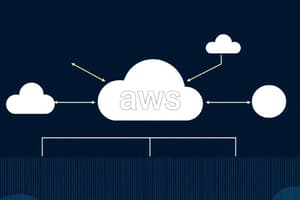Podcast
Questions and Answers
What is a key feature of serverless architecture regarding scaling?
What is a key feature of serverless architecture regarding scaling?
How does the cost model of serverless architecture differ from traditional architecture?
How does the cost model of serverless architecture differ from traditional architecture?
Which scenario is most suited for using serverless architecture?
Which scenario is most suited for using serverless architecture?
What is a typical characteristic of traditional architecture compared to serverless?
What is a typical characteristic of traditional architecture compared to serverless?
Signup and view all the answers
Which of the following statements is true regarding the choice between serverless and traditional architecture?
Which of the following statements is true regarding the choice between serverless and traditional architecture?
Signup and view all the answers
What is a significant latency issue associated with cold starts?
What is a significant latency issue associated with cold starts?
Signup and view all the answers
Which characteristic of traditional server-based architecture requires manual intervention from developers?
Which characteristic of traditional server-based architecture requires manual intervention from developers?
Signup and view all the answers
How do traditional server-based architectures typically handle billing?
How do traditional server-based architectures typically handle billing?
Signup and view all the answers
What is a defining trait of the operational behavior of servers in traditional architecture?
What is a defining trait of the operational behavior of servers in traditional architecture?
Signup and view all the answers
What is a major downside of having fixed resources in traditional server architecture?
What is a major downside of having fixed resources in traditional server architecture?
Signup and view all the answers
Which of the following best describes the maintenance responsibility in traditional server architecture?
Which of the following best describes the maintenance responsibility in traditional server architecture?
Signup and view all the answers
What impact does continuous operation of servers have on resource efficiency?
What impact does continuous operation of servers have on resource efficiency?
Signup and view all the answers
In traditional server architecture, which of the following is less flexible compared to serverless options?
In traditional server architecture, which of the following is less flexible compared to serverless options?
Signup and view all the answers
What characterizes the functions in serverless architecture?
What characterizes the functions in serverless architecture?
Signup and view all the answers
Which statement is true regarding serverless and traditional architectures?
Which statement is true regarding serverless and traditional architectures?
Signup and view all the answers
Which of the following is NOT characteristic of serverless architecture?
Which of the following is NOT characteristic of serverless architecture?
Signup and view all the answers
What type of applications mainly benefit from serverless architecture?
What type of applications mainly benefit from serverless architecture?
Signup and view all the answers
What kind of events can trigger serverless functions in an application?
What kind of events can trigger serverless functions in an application?
Signup and view all the answers
What is one of the primary benefits of reduced operational overhead in serverless computing?
What is one of the primary benefits of reduced operational overhead in serverless computing?
Signup and view all the answers
What is one significant advantage of using dedicated server hosting?
What is one significant advantage of using dedicated server hosting?
Signup and view all the answers
Which of the following is a disadvantage of using dedicated servers?
Which of the following is a disadvantage of using dedicated servers?
Signup and view all the answers
What major difference exists between serverless architecture and traditional server hosting?
What major difference exists between serverless architecture and traditional server hosting?
Signup and view all the answers
Why is flexibility considered a benefit of dedicated server hosting?
Why is flexibility considered a benefit of dedicated server hosting?
Signup and view all the answers
What is one of the responsibilities of a team managing a dedicated server?
What is one of the responsibilities of a team managing a dedicated server?
Signup and view all the answers
What does operational complexity refer to in the context of dedicated server hosting?
What does operational complexity refer to in the context of dedicated server hosting?
Signup and view all the answers
Study Notes
Serverless Architecture vs Traditional Server-Based Architecture
-
Serverless Architecture:
- Definition: The cloud provider dynamically manages server allocation and provisioning. Developers focus on code, not infrastructure.
-
Characteristics:
- Dynamic Scaling: Automatically adjusts resources based on demand.
- Billing Model: Costs are based on actual usage (function executions or time).
- Stateless: Functions are independent and executed in response to events (e.g., image uploads).
- Example: Photo sharing applications where backend tasks (resizing images, processing metadata) are handled by serverless functions.
-
Pros:
- Reduced Operational Overhead: No server management needed.
-
Traditional Server-Based Architecture:
- Definition: Applications are deployed, maintained, and scaled by the developer or operations team on dedicated servers.
-
Characteristics:
- Fixed Resources: Servers have predefined resources that need manual scaling.
- Continuous Operation: Servers run continuously, regardless of demand.
- Billing Model: Typically ongoing costs regardless of usage (including maintenance).
- Example: Company websites hosted on dedicated servers or shared hosting services.
-
Pros:
- Full Control: Complete control over server environment and infrastructure.
- Flexibility: More flexibility in configuring and optimizing the server.
-
Cons:
- Higher Costs: Costs for unused server capacity and continuous maintenance.
- Operational Complexity: Requires active management of the server infrastructure.
- Limited Control: Limited control over the environment and underlying infrastructure.
- Cold Starts: Potential latency issues when initializing a function.
- High Scalability: May require manual scaling to accommodate peak loads.
Key Differences
- Infrastructure Management: Serverless abstracts away server management; traditional requires active management.
- Scaling: Serverless automatically scales with demand; traditional requires manual adjustments.
- Cost Model: Serverless is a pay-as-you-go model; traditional involves ongoing costs.
Conclusion
- Serverless architecture is ideal for applications with variable workloads where simplifying management and reducing costs is prioritized.
- Traditional server-based architecture is suitable for applications requiring extensive control over the environment and predictable performance.
- Choosing the right architecture depends on application needs, workload patterns, and operational preferences.
Studying That Suits You
Use AI to generate personalized quizzes and flashcards to suit your learning preferences.
Related Documents
Description
This quiz explores the key differences between serverless architecture and traditional server-based architecture. You will learn about their definitions, characteristics, pros, and examples, which will help you understand the advantages and disadvantages of each approach. Ideal for developers and IT professionals looking to enhance their knowledge in cloud computing.




